Mi¹ko ©uvakoviæ
Critical Phenomenology of Artwork:
Status and Functions
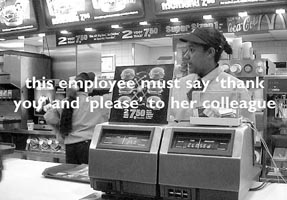 Schie
2.0: Holland is a Well Regulated Country, 1999
Schie
2.0: Holland is a Well Regulated Country, 1999
In a certain moment at the beginning of Nineties, in a very particular moment of European history - after the breakdown of Real-Socialism (the Eastern Block) - there was the reconstitution of the function of art and the renewing of criteria of ‘validity’ along the lines of ‘political correctness’ in the Post-Block world. Art has become anew ‘a matter of culture’ with certain functions of mediating the positive social interest in the sense of public or general politics and ethics. The new art of the Nineties obtains social functions (the function of culture and practical politics) of mediation between the possible worlds (the centre, differentiating margins, transitional formations, crisis points) as well as the social function of creating an atmosphere of expected political correctness in a Europe deprived of totalitarian divisions. The formulations of painting and sculpture are being replaced with the formulations of open information work (video, installation, photography, linguistic-visual inter-text). Open information work represents the erased trace of site-specific culture (of the region, city, street, apartment, human body or geographic macro-space). A work of art is the inscription of layered and selected traces of culture ‘of’ a certain located specific place and situation. The ontology and the morphology of these ‘contemporary’ works is not an autonomous aesthetic form or occurrence, but it is conditioned by the unstable and adaptable:
(a) phenomenology of information;
(b) structural functionality
of the context and
(c) the logic of narration
in the conceptual order of
the articulation of meaning (attitude, point of view and social value).
This is an art made ‘of’ narrative, representative and transferred traces
and effects of a concrete culture. In other words:
(i) while traditional
realistic approach of the nineteenth or the social ones of the twentieth
century strove towards a faithful or optimal depiction of the world outside
art,
(ii) while Avant-garde
and Neo-Avant-garde Anti-or-Post-Art ‘Realisms’ (Concrete Art, New Realism,
Neo-Dada, Pop Art, Arte Povera) strove towards a literal post-Duchampian
transfer of the objects from the world outside art into the extraordinary
and critical world of art,
(iii) Realism (Soros
Realism, Multicultural Realism) at the end of the Nineties emerged
as a media presentation of real as well as fictional information and their
erased and transferred traces through the relation of image and word in
the process of constituting the social ideology of Globalisation, that
is to say, the post-conflict Europe.
The Ontology of Artwork in the Nineties
One of the characteristics of the Nineties is the redefinition of the ontology of artwork according to the idea of the work of art as critical information in the conceptual art of the Sixties and the Seventies. The difference is that ‘the new work of the Nineties’ is being realised according to the massive media infrastructure of late Postmodernism with the expectations of the positive micro-social projection of political correctness (environment, local customs, the logic or repression of everyday life, the rights of the margin in relation to the center, the gender issue, discursive formations of identity). This new art finds itself between the critique and the apology of social reality; in itself, it is an offer to reality as an imaginary and symbolical representation of possible ‘co-existence’ of identities and their differences. But how did this particular ontology of artwork occur?
We should start with the models
constituted in the Conceptual art of the early and mid-Seventies. Joseph
Kosuth, for instance, has explicitly established uncertain assumptions
that were a direct attack on the Greenbergian Modernistic autonomy of
the artwork as an established form or an expression of individual creative
efforts of the artist(1) :
(i) according to him,
‘Function refers to “art context”. Art only exists as a context,
that is its nature - has no other qualities. (...) With the functioning
of sets within sets, boundaries are temporary and arbitrary and wholly
dependent on a sense of “purpose”’(2)
(ii) furthermore, he
promised in several projects the essential relation between the text and
the context in the process of manufacturing of the meaning: ‘Text/Context:
It is the intention of this work to further make/show the nature of the
activity (“making meaning”) to be a contingent, contextual aspect of cultural
processes (with art being a concrete instance)’(3); he eventually
(iii) concluded in his
famous critique of Eclectic Painterly Postmodernism of the
Eighties: ‘There are no new forms, only new meanings. An artist is engaged
in the making of meaning, whether it's the cancellation of meaning or
not’(4)
If we separate Kosuth's ideas on critical Conceptual art from their primary function - and that is the critique of Essentialism, Objectivism and Universalism of the high Greenbergian Modernism - then we obtain a scheme which will gain its necessary institutional character in the actual culture of the Nineties. In other words, institutional media executions of function, context and manufacturing of meaning within culture become the essential aspects of an artwork which is no longer based on the concept and the appearance of the designed, executed or expressed form. The artwork is - and this is an ontological category - a mediatic constellation of information by which the functions of context are being presented in the manufacturing of social meaning of problems of Post-Socialistic, European Civil or Liberal American society. Art becomes a sonde for testing and presenting culture in its social capacities of function, context and manufacturing of public meaning. In the climate of the 'New World Order', a subversive yet internally artistic strategy of conceptual art has become relevant, dominant and mainstream: the art of depicting and constituting the social reality.
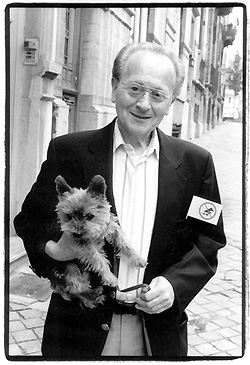 The
Ideology of Manifesta as Read in the Catalogues of Manifesta 1,
2, 3
The
Ideology of Manifesta as Read in the Catalogues of Manifesta 1,
2, 3
The previous remarks singled
out some common features of the presentation of the ideology of the exhibitions
and the catalogues of M 1, 2, 3. I will take up the catalogues for a moment.
They are over-designed, unintelligible, opaque... They offer an abundance
of heterogenous materials whose meaning or sense do not derive from painterly,
sculptural or visual appearance, but from the offered conceptual and narrative
instructions, descriptions or contents which are parallel to the visual
material. It is difficult to discern the information on the artist, the
artwork itself and the documents on the art and culture from which they
derive. There is an obvious overlapping of the ‘inscription’ of art and
the ‘inscription’ of culture in the field of perception that is the reading
(the deciphering of signs). Joseph Kosuth once said very precisely that
nowadays there is no difference between a Van Gogh's painting and the
palette on which he was mixing colours(5). Textual concepts or narrations
are a necessary supplement (explanation, an introduction into the offer
and the possibilities of meaning) to the visual material which would remain
as an unintelligible arbitrary document of some
out-of-art event on which the work of art and its presentation refer to.
This means that the catalogue is in itself an archive of information
(discursive objects) which do not have necessarily to be extracted and
identified - that is, judged - as an object of aesthetic enjoyment, identification
and understanding in a Modernistic sense. Every M catalogue is re-constructed
according to the models:
(a) of presentation of “the
idea” of the artist in the way that derives out of historical Conceptual
Art: A work of art is an inter-textual and inter-visual order of information
in the process of re-semantisation of actuality,
(b) unlike “the critical
idealism” of historical Conceptual Art of the end of the Sixties and the
early Seventies, ‘the themes’ chosen by the artists of the second half
of the Nineties do not belong to the narrow domain of exploration of art
as art and art as an extraordinary excess within culture; they rather
belong to the wide open domain of representation or erasing
of the traces of culture (privatness, public culture, popular culture,
regionalism, marginality, sexuality, consumerism, simulations of promises
of actual culture, the postponing of the artistic, political correctness,
reconcilliation of antagonisms, war, the horror of everyday life, psychological
atmosphere of “the citizen”) within the very information-based system
of social reality in the époque of communication.
(c) the designer's unintelligibility
of the catalogues of M 1, 2, 3 exhibitions is not an accidental
‘lapse’, but a desired effect of the omni-present arbitrariness(6)
of the situation in which the artist (author, manufacturer) is now functioning
as cultural worker (the archivist of erased traces of actual
culture and its potential simulations within the artistic discourses that
are being re-semanticised in art the same way the artifacts are being
semanticised in popular mass culture), and
(d) the relation of “artworks” of Eastern and Western European artists
- in other words, the relation of otherness of Eastern Europe and
the margins of Western Europe - reveals the similarity of products,
i.e. the information morphology of works (in fact, the manner of
representation) and an important difference concerning the displayed fanaticism
- it reveals the tension between
(i) the fanaticism of uncontrolled consumption of information or
values (dominant West), then,
(ii) the phantasm of fear of losing the regional identity (marginal
West), and
(iii) an already worn-out cynicism (or, better said, sentimentalism,
melancholy, hopelessness) of the fulfilled and unfulfilled promise of
consumption after the fall of the Berlin Wall (ex-Eastern Europe).
In other words, there is no more Western autonomous art (from high Modernism to eclectic painterly postmodernisms) and Eastern political art (from Perestroika Art to Retro-Avant-garde art) at M 1, 2, 3. The exhibitions and the catalogues of M 1, 2, 3 are political manifestations based on the confrontation of two or more Europas.
Manifesta 3: Phenomenology of Artwork
M 3 was presented in several different places: in Modern Gallery, in International Graphic Art Centre, in the National Museum of Slovenia, in Cankarjev dom and on various locations in town. The majority of the works at M 3 are not works per se or for their own sake, but works that are determined by the reference (external relation) and the referent (external real or fictitious object, content, narrative). In most cases, the reference is established as follows:
(i) installation-work or
semantic-interactive-intervention-work realised for a specific
location (site specific works), in order to provoke or evoke a
behavioural or semantic reaction of the audience - for instance: the passing
simulational installation of ©ejla Kameriæ(7) which provokes the status
of European and other citizens on the Three Bridges, or the absurd, arbitrary
and behavioural installation of ©kart group(8) on the floor of Modern
Gallery that points out the concern for the dog excrement in a stable
civilised society as Belgium or Slovenia;
(ii) information-on-context-work
or document-on-functions-work realised through a media-mediating
installation (video installation, photographic installation) with textual
instructions as semantic additions which clarify visual “data” (on refugees,
foreign guest workers, domestic rigid legislation, private stories,
homeless, etc.) - for instance, photo installations of the designers'
network Schie 2.0(9) on “rigid” laws in the Netherlands, or a photo-video-text
documentation of Marjetica Potrè(10) on the entropies of modern cities;
(iii) sample-work or
trigger-work realised as installation or video projection that
provokes a certain psychological effect on the spectator - in fact, it
provokes a situation which exposes a schism between ‘the knowledge of
oneself in the world’ and a direct sensory (visual) or body confrontation
with the acting influential object, situation or event -
for instance, the ambiental work of Tomo Saviæ-Gecan(11) embodied as an
empty shrinking white room, or the usage of visual (video) representation
of the artist's body as the representative of a psycho-physiological state
in the video work of Ene-Liis Semper.(12)
How would I comment those six “executions”? In a certain way, I re-acted to them and read them as paradigmatic solutions of ‘the artwork’ through which the uncertain concepts of M 3 could be interpreted.
©ejla Kameriæ's installation
is on the Three Bridges. People are reading the inscriptions. The inscriptions
‘Others’ and ‘EU Citizens’ seem confusing, but attract attention. The
passerbys soon realise that it is a game and they walk away. This
work has an effect:
(1) on those who pass
by the bridge for the first time and read the inscription that doesn't
have a concrete function there on the bridge, although it seems as it
might have, and
(2) on those who have
seen such an inscription at airports and have the experience of passport
control for ‘Others’.
The intervention of inscriptions is semantic. It evokes a certain feeling or memory of embarrassment in the observer. It evokes one's own otherness and its absurdity. It demonstrates that every identity is a discursive product, doesn't it? The location for the work was well chosen - this means, a busy place - and the effect is being multiplied by the large number of accidental participants-passers-by.
The installation of Belgrade
group ©kart (Your Shit, Your Responsibility, 2000) could pass unnoticed.
It is trivial and senseless: they realized it in Brussels and in Ljubljana
and refers to dog excrement, civil responsibility, European hygiene, foreigners
that came from the Balkans where there is no concern for human lives,
let alone the dog excrement, etc.... The work can be understood in a threefold
manner:
(a) as ironising the
trivial, alienated and dehumanised (dog-oriented) human relations in a
civil society,
(b) as a provocation
of the 'senseless and rigid European order' which is concerned even with
the dog excrement, from the side of non-European or Balkan artists who
live in a world where things still unfold in epically dramatic or lethal
way, and
(c) as an expression
of despair of 'Serbian artists' who, in order to enter the game of international
art, have to reach for nonsense tricks like: ‘we are those good guys that
make fun out of everything and everybody in this world’ in a totally
nice and benign way; in other words, they make an international career
out of their cunning innocence that only seemingly provokes something
or somebody, whereas it produces a patronising smile and a comment ‘well,
you are not such bad guys after all’, here is a piece of bread (grant,
per diems, fee) for you.(13)
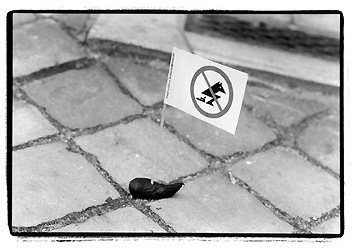 Perhaps
I am being too critical towards the work of ©kart group. However, the
problem is not in them but in the curators that choose such a work as
a sign-symbol for a specific geo-strategic space. Perhaps that is why
their work is also ‘good’; perhaps it is good because it demonstrates
the logic, the concepts and the strategies of curators who build their
strategies of ‘New Humanism’ and ‘care for others’ on the misery
of ex-East-European artists and their wretched mimicry targeted to satisfy
curators' expectations. Yes, this is the reason why the work of ©kart
group is excellent and that is why it speaks about ‘its own status’ as
well as in the name of numerous works at Manifestas.
Perhaps
I am being too critical towards the work of ©kart group. However, the
problem is not in them but in the curators that choose such a work as
a sign-symbol for a specific geo-strategic space. Perhaps that is why
their work is also ‘good’; perhaps it is good because it demonstrates
the logic, the concepts and the strategies of curators who build their
strategies of ‘New Humanism’ and ‘care for others’ on the misery
of ex-East-European artists and their wretched mimicry targeted to satisfy
curators' expectations. Yes, this is the reason why the work of ©kart
group is excellent and that is why it speaks about ‘its own status’ as
well as in the name of numerous works at Manifestas.
The designers' network called Schie 2.0 discovered something entirely different, and that is that the civil society is rigid and boring. This is no particular discovery. In the Nineties, California and Switzerland are much more boring ‘life’ environments than, for instance, Rwanda, Iran, Iraq, Tchetchenya, Serbia, Croatia or Bosnia. This is common place.
The Netherlands is a prototype of such a ‘stable’ and slightly boring society. In the photo-textual installation of Schie 2.0 network (Holland is a Well Regulated Country, 1999), the rigidity of everyday life is brought to an order of signs that represent reality. However, their realism cannot change anything, even not on the level of ‘critical awareness’; this is a designing of notions of reality that seem to be a critique, but they are nothing else than a repetition of dead signs of a task assigned within the strategy of curators' expectations. This work is on the verge of kitsch, as kitsch is what shows itself as the one that it really isn't. This work is an imitation of critical art in order not to execute critique; that everything would remain the same, that the design would only multiply the banal fact that, in a stable society, laws are stupid and rigid.
The series of photographs,
texts and the video installation of Marjetica Potrè (House for Travellers,
2000) confronts two paradoxical intentions:
(i) the intention to
make a work of the type information-inter-visual-inter-textual, and
(ii) the intention to
draw culture (its erased traces, the erased traces of cities) into a game
of artistic re-assigning, in which reality itself is being treated as
the material for the artistic act.
By its documentarity, the work of Marjetica Potrè thus seemingly resembles the other works at M 3; yet, it also departs from them appearing as a gesture of an artist that depicts culture by instruments of art and art by instruments of culture. It is a gesture on the border of fictitious and literal, i.e., between the offer of presence and the indexing of absence. Her work is a game on the very border of art and culture and this saves her from the expected and offered role of cultural worker. She offers the experience of an artist, and not an experience of a cultural worker. The essential difference lies in the experience, its complexity and polysemanticism. Similar visual or media results can correspond to entirely different experiences and selves. This is essential. She has indexed the entropy of the world by means of the instability of art and that's it... Marjetica Potrè is one of the rare ‘artists’ at M who, regardless of her Eastern or Western origin, has not succumbed to the trap of Eastern-European self-pitying. This is good art whose building material is the cultural context and its erased traces. For this reason and in the best sense of the word, her strategies could also serve as basis for subtle curatorial interventions in art-culture interrelation.
Tomo Saviæ-Gecan has created a highly intelligent and effective work (Untitled, 1995-2000): An empty white room in which, at first glance and in the first moment, nothing changes. Void. To an accidental passerby, this work will give an impression of a relapse of Modernist Minimalism, an offer of emptier than empty. But in further visits during the day, a more careful observer will discover that the room is shrinking. One wall is moving and the room is becoming smaller. Claustrophobia. Xenophobia. The work first produces an entirely physical effect; then on the psychological level it provokes the elementary micro-culturology of direct behaviouralism. This is the usage of the power of allegory(14) that depicts culture as a room that loses its inner volume. Yet, this depiction is not narrative but physical, material, semantic. Entering the concrete behavioural performance, the spectator is forced to confront the ‘world itself’ without mediators and additional indexes (textual propositions).
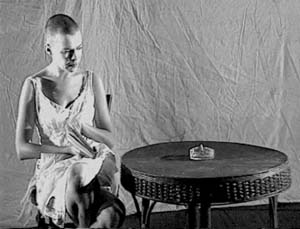 The
work of Ene-Liis Semper (FF/Rew, 1998) leaves a good visual impression
along with an uncertain power of visual constitution of expressive and
absurd atmosphere in the space between life and death. It is a very traditional
work, so traditional that it could be defined by Toma¾ Brejc's term Dark
Modernism(15). This work is executed with high precision: the properties
of video art (static frame, slow motion, repetition, ironic self-view,
visual alienation of the figure) are being used as means for achieving
a powerful expressive image almost in the tradition of Northern Romanticism.
It functions as a mobile expressive image. Irony is here in the function
of expression: it emphasises the expressiveness of the work by distantiation
from subjectivity (as a dramaturgical technique, this can be found in
Beckett). Irony is the arbitrary demonstrated actant. It is the
question of differentiating between the significant and the signifier
in the screen sign; this differentiation is not a mere arbitrariness of
everyday life (as in Schie 2.0) but a focus on the very culturological
absence of motivation between the image and significance (of life, death,
significant and signifier), etc....
The
work of Ene-Liis Semper (FF/Rew, 1998) leaves a good visual impression
along with an uncertain power of visual constitution of expressive and
absurd atmosphere in the space between life and death. It is a very traditional
work, so traditional that it could be defined by Toma¾ Brejc's term Dark
Modernism(15). This work is executed with high precision: the properties
of video art (static frame, slow motion, repetition, ironic self-view,
visual alienation of the figure) are being used as means for achieving
a powerful expressive image almost in the tradition of Northern Romanticism.
It functions as a mobile expressive image. Irony is here in the function
of expression: it emphasises the expressiveness of the work by distantiation
from subjectivity (as a dramaturgical technique, this can be found in
Beckett). Irony is the arbitrary demonstrated actant. It is the
question of differentiating between the significant and the signifier
in the screen sign; this differentiation is not a mere arbitrariness of
everyday life (as in Schie 2.0) but a focus on the very culturological
absence of motivation between the image and significance (of life, death,
significant and signifier), etc....
As many other examples from the M 3 exhibition, these examples point out to the problem of status and functions of art in contemporary world. For, art is being confronted with its own success, the success of becoming reality itself, i.e. the symbolical and imaginary cultural order where that which is in and that which is out of art do not differ anymore... Where fiction is being lost in literalism, or rather, where representation is merely an indicator of the interest of curatorial strategies. Art today has its function and its contexts, expectations and families of intelligibility. After the unintelligibility of the ecstatic Sixties, pluralistic Seventies and eclectic Eighties, there is a certain order and a new kind of intelligibility in the art of the Nineties. Families of similarity can be expected between entirely different works, precisely because they have the same function, although they belong to different contexts. The new intelligibility is achieved and it rules the European art scene ...
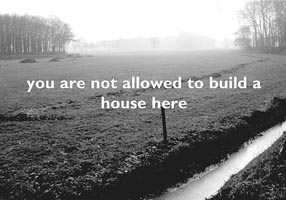
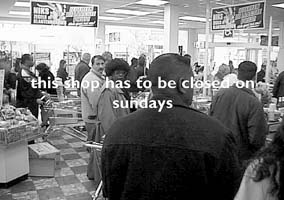 Schie
2.0
Schie
2.0
One Comparison: Artworks at Manifesta 3 and at 2000+ - ArtEast Collection of Modern Gallery exhibition
The comparison of those two exhibitions is inevitable by the very fact of the intention of organisers to present them simultaneously. These two exhibitions are competitive. They are competitive because they are offering a similar concept (art as a trace of culture) and different effects (the exhibited works differ precisely in their ontology and its consequences in the hiatus between the literal and the fictional). In other words, both exhibitions depart from the state of affairs, and that is that the border between art and culture has narrowed down, almost to the point of being annulled.
M 3 establishes the approximate identity: art is culture (with some exceptions). It thus demonstrates how, in reality, art is being lost in culture. Art postpones itself through culture. This occurs by art obtaining its utilitarian function (the representation of social interest, the constitution of reality) and realising this function through a ‘work’ that has information ontology and morphology. At M 3, there is practically no work of the format of ‘piece’.
Contrary to that, the Metelkova exhibition is an exhibition of artworks that were purchased by the museum institution as “valid” (aesthetical-artistic) and “significant” (culturological-historical) works of one époque (from late Modernism to Postmodernism in the era of late Socialism and Post-Socialism). Still, those works are works that, in some ways, directly or indirectly problematise culture (Beuys, ©tembera, Prigov, Mangelos, Stilinoviæ, Todosijeviæ, even Kapoor) but without imitating or simulating it; they don't become cultural artifacts with no artistic features, etc…. The ontology of those artworks is as artistic as the open and unstable Duchampian tradition – to which they mostly belong – allows them.
These two exhibitions are simultaneously posing a similar problem: the relation of art and culture and the indication of different solutions. On the one hand, it is the logic of cultural worker (artist, curator) who re-combines imaginary and symbolic realities of the information world (M 3); on the other hand, it is the logic of the artist of Duchampian tradition who transforms the world into a “trace” (work) which is a certain resistance to the world itself by means of it own material (signifier) skeleton. The Curator him/herself is the one who imitates the artist and moves the artifacts from culture into the exquisiteness of art. Even the building which hosts the exhibition is such a transferred artifact (from a military compound into a museum).
To which exhibition one should give priority? While I was observing the exhibitions, I was more inclined to the collection of Modern Gallery at Metelkova. Now, with a certain time distance, I am not so sure anymore!?!? In other words, I would favour the very rivalry between those two concepts and the two executions of the exhibitions, since art is not merely the work per se, but also the juxtaposition of the possibility to confront the works. Confrontation is art.

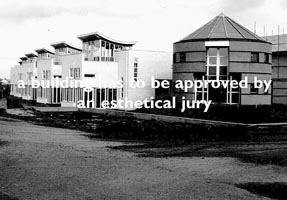 Schie
2.0
Schie
2.0
1. This mainly refers
to the works of Abstract Expressionism and its evolutions up to the Post-painting
and Post-geometrical Abstraction.
2. Joseph Kosuth,
‘Introduction to Function’ (1970), Art after Philosophy and
After. Collected Writings, 1966-1990, The MIT Press, Cambridge, Mass,
1990, p.41.
3. Joseph Kosuth,
‘Text/Context: Seven Remarks for you to Consider while Viewing/Reading
This Exhibition’ (1979), ibid. 2, p.179.
4. Quoted in
Kathy Acker, ‘Impassioned with some song we’, Artforum, New York,
May 1982, p. 68.
5. Joseph Kosuth,
‘Art after Philosophy’ (1969), ibid. 2, p.19.
6. This refers
to de Saussure's concept of the arbitrariness of sign which is being recognised
in Postmodern culture as the essential characteristic feature of every
relation - between any signified and any signifiant there is merely an
arbitrary and temporary relation which is being recognised as a sign,
that is, as an already passed over and erased sign.
7. Manifesta
3 - European Biennial of Contemporary Art; Ed. by Igor Zabel,
Cankarjev dom, Ljubljana, Slovenia, 2000, pp. 98-99 catalogue,
pp. 98-99.
8. Ibid.,
pp. 165-166.
9. Ibid.,
pp. 155-156.
10. Ibid.,
pp. 137-141.
11. Ibid.,
p. 154.
12. Ibid.,
pp. 157-158.
13. The problems
lies in the fact that artists do not have to be nice in order to make
art – I am interested to find
out why Serbian or any other ex-East-European artists are not allowed
to make art, instead of intelligent
building of grantee careers on the account of their innocent helplessness
and playing roles of nice,
or at least endangered, boys and girls...
14. For instance,
Gecan has used the power of allegory the way which Craig Owens has promised
in his essay ‘The Allegorical Impulse: Toward a Theory of Postmodernism’,
from Beyond Recognition. Representation, Power and Culture, University
of California Press, Berkeley, 1992, pp. 52-69.
15. Toma¾ Brejc,
Temni modernizem. Slike, teorije, interpretacije, Cankarjeva
zalo¾ba, Ljubljana, 1991.
(Mi¹ko ©uvakoviæ - theoretician, lecturer of aesthetics at the Faculty of music in Belgrade)